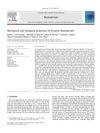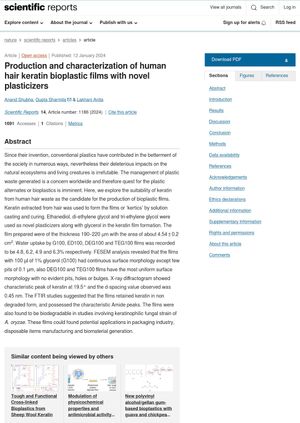TLDR Human hair was used to make biodegradable plastic films that could be useful for packaging and disposable products.
The study used keratin from human hair waste to create bioplastic films, or 'kertics', with the help of novel plasticizers such as ethanediol, di-ethylene glycol, tri-ethylene glycol, and glycerol. The films were 190-220 µm thick, had an area of about 4.54 ± 0.2 cm2, and their water uptake varied between 4.8% and 6.3%. X-ray and FTIR studies confirmed the presence of non-degraded keratin. The films were found to be biodegradable in studies involving a keratinophilic fungal strain of A. oryzae. The study suggests these films could be used in the packaging industry, disposable items manufacturing, and biomaterial generation.
3 citations
,
December 2021 in “Materials today communications” A new film made from human hair supports skin cell growth better than collagen.
76 citations
,
December 2011 in “Journal of Cell Science” Different keratin types have unique amino acid patterns that are evolutionarily conserved.
 140 citations
,
August 2011 in “Biomaterials”
140 citations
,
August 2011 in “Biomaterials” Keratose, derived from human hair, is a non-toxic biomaterial good for tissue regeneration and integrates well with body tissues.
226 citations
,
January 2002 in “Biological and Pharmaceutical Bulletin” A new method quickly extracts and identifies proteins from hair and other keratin sources.
 January 2025 in “International Journal of Molecular Biology and Biochemistry”
January 2025 in “International Journal of Molecular Biology and Biochemistry” The Shindai method effectively extracts keratin from human hair, with potential uses in bioplastics and biofertilizers.
November 2025 in “Journal of Natural Fibers” Human hair waste can be valuable in engineering and materials due to its unique properties.
25 citations
,
November 2022 in “Frontiers in Bioengineering and Biotechnology” Composite biodegradable biomaterials can improve diabetic wound healing but need more development for clinical use.
 2 citations
,
June 2023 in “Pharmaceutics”
2 citations
,
June 2023 in “Pharmaceutics” Nanofiber scaffolds help wounds heal by delivering drugs directly to the injury site.

Plant-based compounds can improve wound dressings and skin medication delivery.




